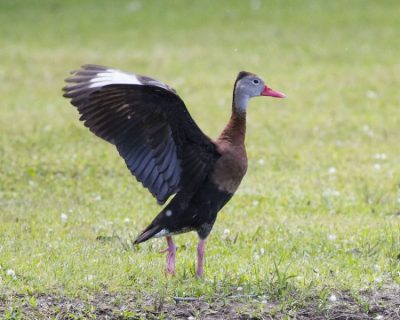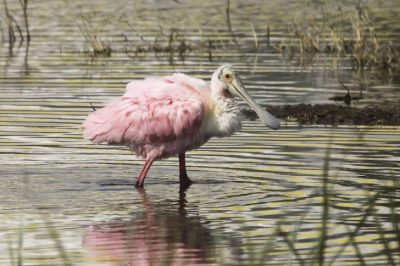Reprinted from the Outer Banks Voice

By June, after long flights from Central and South America, most of our spring migrants have reached their destinations and begun new families.
Supporter Spotlight
The majority of shorebird species are in Canada or Alaska, many of them on the Arctic tundra, where conditions and abundant food are perfect for raising youngsters in a hurry.
The woodland songbirds that didn’t settle here in North Carolina are also far north of us, many of them breeding in lush Canadian forests.
So what’s a birder to look for on the Outer Banks in June?
First, we still have a few species of shorebirds on our beaches and mudflats. Some are are too young to nest, so they stayed behind. Others, like piping plover, Wilson’s plover, killdeer, eastern willet, American oystercatcher, and black-necked stilt actually nest here. In addition, our beaches are full of terns and gulls, many of them nesting.
Second, there is a plethora of breeding songbirds in our forests, scrub habitats, marshes and backyards to entertain us. From warblers to wrens and hummingbirds to hawks, they are available.
Supporter Spotlight
For those birders always looking for something rare, let’s look at several southern species that you just can try for. You may get lucky.
Black-bellied whistling-ducks have been slowly moving northward, with sightings in North Carolina becoming annual. This southern “tree duck” has been seen in Mann’s Harbor twice now, as well as in several other locations in the state. A black-bellied whistling-duck is like a goose, with a long neck, long legs, a black belly and a bright red bill. They almost never stay in one location for long, apparently liking their frustrating status as “one-day wonders.”
Mottled ducks have not been seen in Dare County yet, but will undoubtedly show up here eventually. Looking like a black duck, but lighter, with a very pale head, these dabbling ducks are gradually extending their breeding range northward. Wouldn’t it be exciting to find the first one ever recorded in Dare County?
Wood stork is another southern species that is expanding its range northward. There are already several large colonies in the southern coastal section of North Carolina and stray birds have been showing up in Dare County for several years now, including in 2018. These are unmistakable, large, black and white wading birds with heavy, down-curved bills. Wood storks have been spotted feeding in ditches, roosting in trees and soaring overhead.

Limpkin is a species that I’ve personally been anxiously waiting to add to my North Carolina list. Limpkins are large, brown and white-streaked wading birds normally found in swamps and wetlands in Florida. In recent years, there have been several reports north of Florida, including in North Carolina. One was spotted May 22 in Mecklenburg County.
Yet another wading bird from the Deep South that is possible in our area is the roseate spoonbill. 2018 was a banner year for this large wading bird, with several seen in our area, and there is no reason it can’t happen again. Look for this beautiful, spoon-billed bird at Pea Island and other wet habitats. You can’t mess up on the ID – it’s pink!
Search high in the air over the ocean for magnificent frigatebird. Although rare in our area, these “man-o-war” birds are seen annually in summer along our coast. They spend practically all of their time searching for fish, which they either steal from other birds or snatch from the water’s surface. Frigatebirds are easily identified by their dark plumage, 7 to 8-foot wingspan and a long, forked tail. This is a huge “wow” bird.
Purple gallinule is another awesome bird that makes its home in the Deep South but is sometimes seen in our area. Keep an eye out for them in densely vegetated wet habitats, such as swamps, marshes and even roadside ditches. More than one has been spotted in the ditch in south Nags Head in recent years. Look for a purplish-blue chicken-like bird, with huge yellow feet and a red and yellow bill. Purple gallinules are often seen walking on top of floating vegetation, feeding on plant parts and small animal matter.
The swallow-tailed kite is arguably our most graceful bird-of-prey. White with black trailing wing edges and a long, black, deeply forked tail, these beautiful birds are like no other. Historically breeding from Florida to South Carolina, these birds have now moved north and are nesting in southern North Carolina bottomlands along the Cape Fear River.
They are usually seen in spring and summer along our coastline, but may also be seen slightly inland. They hunt on the wing, catching flying insects; also dropping down to catch small snakes and lizards. You’ll never forget your first sighting of this graceful raptor. It’s always a good day when you see a swallow-tailed kite.

Gray kingbird, a summer resident from Florida to South Carolina is almost annual in Dare County. Similar to our common eastern kingbird, gray kingbirds are paler gray on the back, lack the white terminal band on the tail and have a heavier bill. They prefer open habitats, where they fly-catch for food from a low perch.
Shiny cowbird is another species to look for. A South American brood parasite that has spread northward, there were several sightings in North Carolina in the 1990s and early 2000s, but no reports in recent years.
They have been seen on Pea Island, Bodie Island and in Stumpy Point. Similar to our common brown-headed cowbird, but with a glossy purple head instead of a brown one, and a thinner, sharper bill. The females are more difficult to distinguish, looking very similar, but darker than, brown-headed cowbirds.
Very unlikely, but entirely possible, black-whiskered vireo has been seen several times in North Carolina, including once in Dare County, in my yard!
May and June seem to be the best months. Normally found in the mangrove swamps of Florida, mine was singing high in an oak in Manteo. Black-whiskered vireos look very similar to our common red-eyed vireos but have a larger bill and a different pattern on the face, including a dark malar stripe. Consult a good field guide.
Good luck, and let the birding world know if you find any of these gems. See you in the field!







